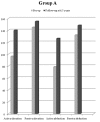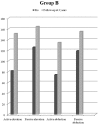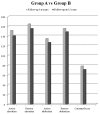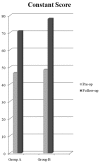Partial repair in irreparable rotator cuff tear: our experience in long-term follow-up
- PMID: 29083356
- PMCID: PMC6357661
- DOI: 10.23750/abm.v88i4-S.6796
Partial repair in irreparable rotator cuff tear: our experience in long-term follow-up
Abstract
Aim of the work: Massive rotator cuff tears are a common source of shoulder pain and dysfunction, especially in middle age patient; these lesions represent about 20% of all rotator cuff tears and 80% of recurrent tears. Some lesions are not repairable or should not be repaired: in this case, a rotator cuff partial repair should be recommended. The aim of the study is to evaluate the outcome of rotator cuff partial repair in irreparable rotator cuff massive tear at medium and long-term follow-up.
Materials and method: We have evaluated 74 consecutive patients treated with functional repair of rotator cuff by the same surgeon between 2006 and 2014. We divided patients into 2 groups, obtaining 2 average follow-up: at about 6,5 (group A) and 3 years (group B). In December 2015, we evaluated in every patient ROM and Constant Score. We analyzed difference between pre-operatory data and the 2 groups. Results: We found statistical significant difference in ROM and in Constant Score between pre-operatory data and group A and group B. Between group A and group B there is relevant difference in Constant Score but not in ROM.
Conclusions: Partial repair can give good results in a medium follow-up, in terms of pain relief and improvement of ROM, as well as in quality of life. Difference in ROM and Constant Score between group A and group B may indicate the begin of partial repair failure; according to our data, 6-7 years may be the time limit for this surgery technique.
Keywords: massive rotator cuff tear, irreparable rotator cuff tear, shoulder arthroscopy, partial repair.
Figures






References
-
- Lädermann A, Denard PJ, Collin P. Massive rotator cuff tears definition and treatment. International Orthopaedics (SICOT) 2015;39:2403–14. - PubMed
-
- Porcellini G, Castagna A, Cesari E,Merolla G, Pellegrini A, Paladini P. Partial repair of irreparable supraspinatus tendon tears: clinical and radiographic evaluations at long-term follow-up. J Shoulder Elbow Surg. 2011;20:1170–7. - PubMed
-
- Cofield RH. Subscapular muscle transposition for repair of chronic rotator cuff tears. Surg Gynecol Obstet. 1982;154:667–72. - PubMed
-
- Gerber C, Fuchs B, Hodler J. The results of repair of massive tears of the rotator cuff. J Bone Joint Surg Am. 2000;82:505–15. - PubMed
-
- Castricini R, Benedetto M, Orlando N, Gervasi E, Castagna A, et al. Irreparable rotator cuff tears: a novel classification system. Musculoskelet Surg. 2014;98(Suppl 1):S49–S53. - PubMed
MeSH terms
LinkOut - more resources
Full Text Sources
Medical
Research Materials
